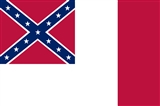
slave state
s of the United States of America
that had declared their secession from the U.S.
Secessionists argued that the United States Constitution
was a compact among states which each state could abandon without consultation, each state having a right to secede. The U.S.
1861 American Civil War: In Montgomery, Alabama, delegates from six break-away U.S. states meet and form the Confederate States of America.
1861 American Civil War: Jefferson Davis is elected the Provisional President of the Confederate States of America by the Confederate convention at Montgomery, Alabama.
1861 In Montgomery, Alabama, Jefferson Davis is inaugurated as the provisional President of the Confederate States of America.
1861 First national flag of the Confederate States of America (the "Stars and Bars") is adopted.
1861 Edward Clark becomes Governor of Texas, replacing Sam Houston, who was evicted from the office for refusing to take an oath of loyalty to the Confederacy.
1861 American Civil War: The war begins with Confederate forces firing on Fort Sumter, in the harbor of Charleston, South Carolina.
1861 American Civil War: Richmond, Virginia is declared the new capital of the Confederate States of America.
1861 American Civil War: Richmond, Virginia is named the capital of the Confederate States of America.
1861 American Civil War: Queen Victoria of the United Kingdom issues a "proclamation of neutrality" which recognizes the breakaway states as having belligerent rights.
1861 American Civil War: The state of Kentucky proclaims its neutrality, which will last until September 3 when Confederate forces enter the state.

